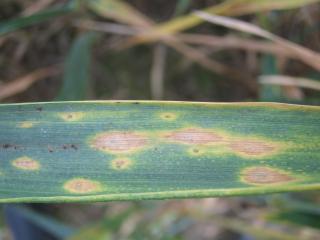Latest Briefing in Ecosystems and biodiversity for 2010

Future disease threats to food crops - are we prepared?
Monitoring crops for new threats provides an early warning of emerging problems affecting food production & quality.
Crops are continually affected by new pest weed and disease threats, and early recognition is important to understand their importance to Scottish food production. Long term changes in the climate may also lead to an increase in new outbreaks and also changes in the types of crops grown in Scotland. Maize is an example of a crop which is likely to increase in area, bringing with it new disease problems which can affect food quality.
When potatoes were first introduced into Europe, no major problems were documented. The fungal disease late blight struck Europe in the 1840s leading to poor harvests which resulted in famine in Ireland and Scotland. Starvation and mass emigration were the consequences of these famines.
Since the Corn Laws put high duties on imported grain, it was not the shortage of food per se, but a shortage of affordable food which caused so much misery. You can travel on destitution roads in Scotland which were built to provide work for people who could not afford to buy grain as a consequence.
Plant pathology was in its infancy at that time and although fungal diseases had been associated with poor harvests, they were not thought to be the primary cause of the damage, hence the lack of knowledge about this disease.
Read morePublished on 18 October 2010 in Sustainability and Communities , Climate, water and energy , Ecosystems and biodiversity
Briefings in Ecosystems and biodiversity for 2010
Taxonomy as a Science for Scotland
Published on 8 October 2010 in Ecosystems and biodiversity
Inventory of Bryophytes in the Gaoligong Shan, Yunnan, China
The Biotic Survey of Gaoligong Shan, Yunnan is one of the biggest exploratory biological surveys ever undertaken in China, and has resulted in collection over the years 2002 to 2007 of over 25,000 fully documented plant specimens as well as countless insects and other invertebrates. Read more
Published on 6 October 2010 in Ecosystems and biodiversity
Conservation Collections in Response to Global Plant Conservation Strategies
In response to Target 8 of the Global Strategy for Plant Conservation a project was initiated in the UK by the Botanic Garden community to encourage Botanic Gardens to grow plants from their own region to develop conservation collections. Read more
Published on 28 September 2010 in Climate, water and energy , Ecosystems and biodiversity
Public Views on Biodiversity Change: The Role of Invasive Non-Native Species
Worldwide there is growing concern among policymakers and conservation biologists over the impact of invasive non-native species on native biodiversity and ecosystems, reflected by an increasing number of policy documents that refer to biological invasions and numerous examples of conservation action aiming to reduce impacts of such invasions. Read more
Published on 2 August 2010 in Ecosystems and biodiversity
Molecular Epidemiology: Fingerprinting the culprit
Within even species of bacteria, parasite and virus there are can be several different strains; each are unique and capable of causing very different diseases in livestock and man. Read more
Published on 27 July 2010 in Sustainability and Communities , Ecosystems and biodiversity , Food, health and wellbeing
How cost-effective are diffuse pollution measures in real agricultural landscapes?
The European Water Framework Directive (EC, 2000) requires Member States to set water quality objectives and identify cost-effective mitigation measures to achieve good ecological status (GES) for all waters in Europe. Read more
Published on 12 July 2010 in Ecosystems and biodiversity , Food, health and wellbeing
Insufficient Evidence For Culling Mountain Hares For Tick And Louping-Ill Virus (LIV) Control
Mountain hares and sheep have been implicated in transmitting the louping ill virus (LIV) to red grouse, which have been in long-term decline. Read more
Published on 29 June 2010 in Ecosystems and biodiversity
Understanding Public Attitudes For Biodiversity Management
Creating a 'greener' Scotland is one of the five strategic objectives underpinning the Scottish Government's work. Read more
Published on 16 June 2010 in Ecosystems and biodiversity
Species Translocations And Environmental Change: A Useful Tool For Biodiversity Conservation?
There is considerable evidence that as climate change progresses species are moving in order to track their preferred climate. Read more
Published on 11 June 2010 in Ecosystems and biodiversity
Understanding The Causes And Consequences Of Rarity In Scottish Plants
Conservation effort has commonly focussed on rare species. Although numerous factors such as land use or climate change may lead to rarity, becoming rare may itself reduce the chances of long-term species survival. Read more
Published on 11 June 2010 in Ecosystems and biodiversity







